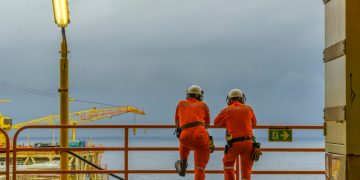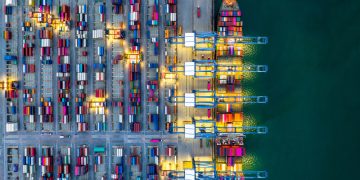Gernot Ruppelt, CEO of Ardmore Shipping, talks to SAFETY4SEA about his key priorities since becoming the new Chief Executive Officer in September.
He expresses satisfaction with crucial areas of the maritime industry, such as safety, compliance, and vetting. However, he emphasizes that more attention needs to be given to seafarers’ mental health. As the energy transition progresses, the industry must join forces to support its seafarers. Engaging them in direct dialogue and actively listening to their feedback is crucial.
SAFETY4SEA: What are your top priorities on the agenda taking the helm as Ardmore’s new CEO from September?
Gernot Ruppelt: Our leadership transition has been long-planned and we’re already on a highly positive trajectory, so my focus as incoming CEO is primarily on building on our success and strategic continuity. While this involves maintaining the momentum we’ve built, our strategy also includes the continuation of our evolution as an organisation, staying nimble and embracing change to adapt to industry changes. Innovation is central to this, whether through integrating new technologies to enhance fuel efficiency or leveraging machine learning to optimize our operations. Additionally, identifying and capitalizing on opportunities, such as fleet modernization and strategic asset plays, remains key, all while nurturing and advancing our strong, forward-looking company culture.
S4S: What are the main challenges you are facing in your new role?
G.R.: The main challenges revolve around evolving strategically, financially, and operationally to maintain our competitive edge, while staying true to our principles of value creation. We’ve benefited from exceptionally strong markets recently, which has been a huge advantage. It’s allowed us to reduce debt significantly, pay meaningful dividends, and renew our fleet. However, with these market conditions, asset values have increased, making it more challenging to find deals that offer clear value. But that’s a reality we must accept. You can’t fight the market; instead, you need to position yourself wisely, being patient and decisive when the right opportunities arise. Ultimately, the challenge is to balance immediate market conditions with the need to ensure we remain adaptable and sustainable for the future.
S4S: What role do you see the energy and digital transformation playing in industry’s future? How do you see the future of Ardmore in the context of the broader shipping industry’s trends and challenges?
G.R.: For Ardmore, energy efficiency and technology integration have always been in our DNA. Since our founding, we’ve prioritized fuel efficiency, embraced onboard telemetry for granular fuel performance analysis, and diversified into chemicals and non-CPP cargos. The broader industry is now aligning with these trends, which have always been central to our strategy. We welcome these shifts and continue to embrace them, as they reflect what we’ve been doing all along.
S4S: With 23 years of experience across multiple sectors in the maritime industry, what key lessons have you learned and what advice would you give to others?
G.R.: Markets and trends are transient, so it’s crucial to transcend the noise and focus on the bigger picture, while remaining nimble in the present. For those starting their journey, my advice is to approach the world with curiosity and humility. Be opportunistic, yet loyal to your principles and your identity. Remember that your name and reputation is something you carry with you throughout your career. Additionally – and importantly – keep a sense of humor. Markets and industry cyclicality can be tough enough, and humor might just be mankind’s quintessential coping mechanism!
S4S: How will the industry’s workforce look in 2030? What can we expect to remain the same, and what will be different?
G.R.: The human element will remain crucial, complemented by technology as a co-pilot to enhance performance. The future isn’t about choosing between human and machine, but about integrating both to achieve better outcomes. There will also be a strong need for mobility; professionals need to understand their cultural roots while being prepared to pursue global opportunities.
S4S: What can the industry do to help engage seafarers who feel like they may not have a voice in the energy transition?
G.R.: In the maritime industry, engaging seafarers in the energy transition is not just about talking about them but, more importantly, talking to them. Seafarers are at the forefront of where energy efficiency truly matters, and they often have invaluable insights and ideas. Engaging them directly in dialogue and actively listening to their feedback is crucial.
S4S: What is your wish list for the industry and/or regulators and all parties involved for addressing the critical issue of crew welfare?
G.R.: The maritime industry has made significant strides in focusing on the ‘hard measures’ of safety, marine compliance, vetting records, and ensuring the physical safety of people, machinery and cargo. These aspects are undoubtedly crucial, forming the backbone of any effective operation at sea. However, one area that remains critically under-addressed is the mental well-being of our seafarers, who are the unsung heroes of global trade.
Our seafarers spend extended periods away from their families, working in high-pressure environments that involve very real risks, navigating harsh weather conditions and sometimes operating in difficult regions. The psychological toll of such conditions cannot be underestimated. Under no circumstances is it acceptable to overlook the mental strain that these conditions place on a person. And the industry as a whole has not given this issue the attention it deserves.
S4S: How can we create the right culture and mindset for an ESG-fit maritime industry?
G.R.: Creating the right culture and mindset for an ESG-fit maritime industry involves integrating performance goals with a progressive mindset. It’s crucial that ESG targets are closely aligned with business objectives, making sustainability a core aspect of operations, rather than an afterthought. This integration requires clear regulatory guidance, consistency, and a framework with both incentives for compliance and disincentives for non-compliance. Without this, companies may struggle with fragmented efforts, undermining meaningful change.
S4S: This year, the IMO WMD theme is dedicated to enhanced safety in the era of new technologies and alternative fuels. What needs to be considered in order to keep pace with the latest updates and maintain a balance between safety and innovation?
G.R.: Innovation is the lifeblood of any industry, especially in maritime, where technological advancements and the adoption of alternative fuels are crucial for sustainability and competitiveness. However, as we embrace these changes, safety is non-negotiable. The balance between innovation and safety is a necessity.
S4S: What would it take for the maritime industry to achieve diversity, equality, and inclusion? What role does management play in this shift?
G.R.: Management must lead by example with less talk and more action. At Ardmore, we have diversity at every level, from the boardroom to general management, which sets us apart in the industry. We are also an active member of the Diversity Study Group, which is a valuable organisation that helps us to benchmark our progress with our industry peers. Diversity should not just be an ESG buzzword; it’s a business advantage that leads to better decision-making, broader market access, and a more engaging work environment.
S4S: If you could change one thing across the industry from your perspective, what would this be and why?
G.R.: Governance standards vary greatly across the industry, which sometimes casts a shadow over our sector. I find this regrettable. However, this variability also presents an opportunity to differentiate ourselves as a company. The maritime industry enables global trade, mobility and access to energy, and even cultural exchange – and we should celebrate that. By raising governance standards, we can improve the industry’s reputation and ensure it continues to thrive.
S4S: What is your key message to industry stakeholders to foster a more sustainable future for shipping?
G.R.: The future is now. While many uncertainties exist, such as the fuel of the future or upcoming regulations, there’s a lot we can do today. Efficiency, particularly in carbon management, should be an ongoing mission. By continually optimizing within our current regulatory and technological frameworks, we can make meaningful progress towards a sustainable future.
The views presented are only those of the authors and do not necessarily reflect those of SAFETY4SEA and are for information sharing and discussion purposes only.




























































